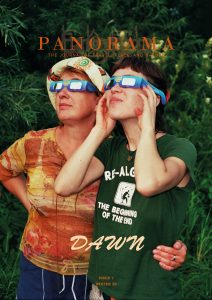The German verb erinnern was always one of the hardest for me to master. First there were its multiple syllables, without a hint as to which to emphasise. Then there was the reflexive pronoun and the preposition that went with it, turning what should have rightfully been one word into three: sich erinnern an. I struggled with where to place each part of this word-phrase in a sentence, especially when every German sentence has multiple correct versions. It turns out that erinnern has two meanings: to remember something, and to remind someone: a simultaneous awareness of things past, and an encouragement to others to share in that awareness.
Berliners have had a long, difficult relationship with the act of remembering. The history they grapple with encompasses not just one totalitarian regime, but two. Memories are the city’s lifeblood; reckoning with the past very often its goal. But that’s what makes it exciting to walk its streets, to weave in and out of its buildings, and to stumble – sometimes literally, as in the case of the Stolpersteine or ‘stumbling stones’– across its every monument.
If you’ve been to Berlin you’ve probably seen at least a few of those stumbling stones – Gunter Demnig’s small brass plaques, placed in front of apartment buildings to mark the Jews who lived there before they were deported and murdered or, occasionally, got out in time. You’ve no doubt walked among Peter Eisenman’s stark stellae, the undulating tombstones just south of the Brandenburg Gate that comprise the Memorial to the Murdered Jews of Europe. Of course you’ve visited the Jewish Museum, Daniel Libeskind’s memorial to Jewish heritage and self-congratulatory ode to himself. Perhaps, too, you’ve come across the city’s countless cemeteries and small poignant statues, each emerging from the everyday as if to say, “We have done our duty in remembering, now move along.”
Ponder the past too often, though, and its weight becomes crushing. Open yourself up to multiple histories, and the sheer act of being in such a city can become overwhelming. On my walks through Berlin, I’m often reminded of George Eliot’s line in Middlemarch: “[I]f we had a keen vision and feeling of all ordinary human life…we should die of that roar which lies on the other side of silence.”
To exist in Berlin is to contend with several images at once: to look up at a building, glance around a street corner, and see both what is there and, like a Magic Eye image, what was once there, coming into focus if you squint your eyes just so.
The Places of Remembrance memorial conveys this better than most. And yet, thanks to its location quite far from the tourist circuit, it’s one few Berlin visitors get to see.
Fig I
Location: Northeast corner of Bayerischer Platz
Image: Black musical notes on an orange background
Text: Jews are expelled from all choral groups. 16.8.1933
Places of Remembrance – in German Orte des Erinnerns – isn’t a place, or places, at all. It is a collection of 80 signs erected seemingly at random around the southwest Berlin neighbourhood known as the Bavarian Quarter (Bayerisches Viertel). On one side of each sign is an image or icon; on the other, a text. The images are simple and childlike in design, straightforward with only a few colours and little detail, like pieces from a board game: a loaf of bread, a string of pearls, a wine glass, a hat. The texts are the Nazi rules and regulations passed against Jews from 1933 to 1945.
Both memorial and art project, the signs were installed in 1993 by artists Renata Stih and Frieder Schnock, a professor and an art historian at Berlin’s Beuth Hochschule. Their subtle genius comes into focus a few moments after you first become aware of them: curiosity, followed by shock, as you realise exactly what it is you are looking at, and where.
The double-sided signs, hung high on streetlights and signposts, are meant to disrupt the reverie of passersby – those wandering this genteel neighbourhood, full of grand Prussian buildings with elaborately stuccoed façades, elegant bronze name plates, and front gardens bursting with plant life. They’re meant more for those who live here than those who visit, and that’s probably why the neighbourhood was particularly up in arms about the memorial’s installation over 20 years ago.
Fig 2
Location: In front of the Bayerischer Platz U-Bahn station
Image: Berlin’s U-Bahn logo, a white “U” against a blue background
Text: Jews may only use public transportation on the way to work. 13.9.1941
Complete ban. 24.4.1942
The use of ticket machines is forbidden to Jews. 26.6.1942
Stih and Schnock’s memorial was called ‘controversial’ when it was first installed. “When the first ones were being put up, someone called the police and said, ‘There is anti-Semitic activity going on,’” Stih recounted in a 2013 interview in the New York Review of Books. “[T]hey took down the seventeen we had installed and arrested the two workers we had.” A debate ensued within the city council. Eventually the installation was allowed to proceed with one small change: beneath every sign, a plaque was to hang, designating it as part of a memorial; not a part of daily city life, but a remnant of history.
All it takes to understand why this was a necessary step towards gaining public trust is to walk around the Bavarian Quarter today. The signs exist within a relatively small area, yet it can be hard to find them at first. Once you see one, however, it’s nearly impossible not to see them all: spot the first, walk up to it, and you’ll likely notice another farther down the street, or just around the corner. Their placement draws you onward, towards another and then another, as you’re borne forward ceaselessly into the past. There is no linear path through this memorial, and no way to see all of it without doubling back on yourself. The result, a kind of manufactured disorientation, was no doubt the intention of Stih and Schnock as much as it was the intention of those who originally conceived of the laws.
To engage with this memorial you must accept a feeling of discomfort. To look at these signs today is to be filled with frustration, to feel complicit more than 70 years later. Even the placement of some of the signs is meant to compound this shame: restrictions on daily activities – things we do without thinking about them, like taking a train or going to the post office – taunt from in front of the exact places where people continue doing them today.
Fig 3
Location: In front of a DHL post station, east side of Bayerischer Platz
Image: A blank postcard
Text: Postal workers married to Jews are to be forcibly retired. 8.6.1937
Viewing the signs on a bright Sunday in October, it can be hard to believe anything gruesome ever happened here. Huge yellow and orange leaves spin and dance to the ground like thick pages torn from old books, middle-aged and elderly neighbours greet each other in front of ornate building entrances or sit bundled at outdoor café tables, eager to absorb the last rays of sunshine before the long Berlin winter descends. Toddlers trundle along on Laufräder (‘walking bikes’ – those tiny wooden bicycles without peddles) while older children kick soccer balls against a playground’s chain-link fence.
A part of me understands why residents were against Places of Remembrance. They were against being made to feel uncomfortable in their own neighbourhood, and I can understand that, because I’m often uncomfortable here too. Their children might remark on the colourful images, mistaking these signs for a game or a treasure hunt. Mama, guck mal! Was ist das? – “Mama, look! What is that?” I sympathise with any parent who doesn’t want to give a child ‘the talk,’ whether it’s how babies are made, how kids can turn into bullies, or how an entire nation can descend into madness.
When I was very small, I grappled with this history and what it meant for me. I can no longer remember what triggered the conversation, but I remember the exact spot on our New York City block, how far up the street we were between our home and Broadway. I remember exactly what corner of which apartment building I was looking at when my mother told me what had once been done to Jews in Germany.
I cannot imagine having to break the news to your child when you’re on the other side of it. Es war einmal…. Once upon a time…an evil arose in the world and it all started here, my child, where we now sit. A memorial is a place to bring a school class; to encounter in a park or in a designated part of the city, when you’re good and ready. No wonder parents here did not want these signs, playing cards of past pain, scattered at random on their children’s way to school.
Fig 4
Location: Just outside the playground gate, Heilbronner Strasse
Image: A game of hopscotch
Text: Aryan and non-Aryan children are forbidden to play with each other. 1938
When describing the Bavarian Quarter, it can be easy to fall into the trap of travel magazine proselytising. Words come to mind like ‘genteel,’ ‘leafy,’ ‘old-world’ and ‘grand.’ No other neighbourhood exists like this within Berlin’s inner ring, and that’s not a coincidence, just as the selection of this neighbourhood for this type of memorial was not a coincidence either.
The Bavarian Quarter, built between 1898 and 1908, was largely the work of two brothers, Georg and Salomon Haberland, who had a vision for an upscale residential district that would rise along with the rising fortunes of Berlin’s Jewish population. Georg and Salomon were the founder and director, respectively, of the Berlinische Boden-Gesellschaft, a property development company.
Envisioning a kind of open community, a city within the city, the Haberlands bought up farmland in the district of Schöneberg. They turned soil into stone, furrows into footpaths, and in the process, proclaimed a new era for upper-middle-class, assimilated German Jews. Albert Einstein would come to live here, as would the rabbi and academic Leo Baeck, the photographer Gisèle Freund, and then screenwriter, later to be renowned film director Billy Wilder.
The Bavarian Quarter was the luxurious answer to the working-class squalor of the Scheunenviertel, the area just north of Hackescher Markt now familiar to most tourists as the ‘Old Jewish Quarter.’ That neighbourhood has fitting memorials of its own, but there’s something particularly upsetting about the Bavarian Quarter’s illustrious pedigree, held up against the memories of what would happen next. The neighbourhood was an experiment, in a sense, and Places of Remembrance is proof that that experiment failed. All the wealth, class and education in the world couldn’t save them here, anymore than it saved their unassimilated, Eastern European counterparts across town.
Fig 5
Location: Corner of Haberlandstrasse and Treuchtlinger Strasse
Image: A street sign bearing the words ‘Haberland Straße’
Text: Streets named after Jews are to be renamed. 27.7.1938
For a New York Jew like me, the Bavarian Quarter can feel a lot like the Upper West Side. If not for the war, when more than half the neighbourhood was destroyed by Allied bombs, it would still consist of a neat 2.25 square kilometres of perfectly measured bürgerlich (bourgeois) blocks, lined with five-story, pre-war apartment buildings – the beloved Berliner Altbau – and those ubiquitous gardens, middle-class stamps of approval and means of friendly competition, much like the nearby Kleingartenkolonien or small garden plots.
The people who live here are settled. They don’t take part in Berlin’s infamously hedonistic nightlife, don’t often go out late to parties, and tend not to cross the old East-West border too often. They are distinctly upper middle class; well-to-do doctors and lawyers and accountants, either raising families or watching grown children start their own.
I moved here because I envisioned myself joining their ranks. But assimilation, as it turns out, isn’t as simple as the desire for it. I found myself wandering these streets feeling proud that my compatriots had been here, built this, seen fit to plan out what was surely Berlin’s most beautiful neighbourhood. But of course, in paying tribute to that history, in envisioning myself as a natural heir to this distinguished heritage, I also had to accept a gruesome reality: I would not have escaped what was to come anymore than they did. Today the signs are there for all to see, but we can only look back on the residents of the Bavarian Quarter, on the staid, established lives they must have lived, and shake our heads at the signs they did not heed.
Fig 6
Location: Meraner Strasse
Image: The gilded lid of a jewellery box
Text: Jewellery and other valuables may not be taken out of the country when emigrating. 16.1.1939
Now when I explore the Bavarian Quarter, my neighbourhood, I think of how I will soon look back on these walks through the eyes of someone who no longer lives here. My near-decade in Berlin is a memory in the making: I visit every museum, restaurant or shop with the thought, resigned and bittersweet, that this time may be the last time.
I’m leaving Berlin for good next year. I’m relinquishing my adopted home for my native city. The many things that were on a path to improving when I left the US now seem to be getting distinctly worse. Were they moving towards their natural state nine years ago, or are they on their way there now?
In discussing the current state of affairs in the US, we spend an inordinate amount of time fretting about how future generations will look back on us. This act of looking forward to look back can seem so complicated it requires its own verb tense. What should we have done now? When will we have known that it was too late to do anything? With every great historical moment, every triumph or tragedy that led to the system being toppled, the unthinkable becoming inevitable, the horror of what could happen becoming the horror of what did, there are those who act and those who step aside. The first is by no means easy; for the second there are no guarantees.
We speak about memory as if knowing the past means we know better. But those who acted were not acting for our benefit; they were simply trying to survive. As I go through my belongings, marking some to sell and others to ship, I think forward to a time not so far away, when I will be looking back on my life in Berlin.
Every time I visit New York City, there are a few first mornings when, upon waking, I have the fleeting sense that Berlin wasn’t real: that that other life in another country and another language actually belonged to another person, or was only a rapidly fading dream. In the future, perhaps instead of remembering Berlin, I’ll have to remind myself to remember it; one meaning of erinnern supplanted by the other.
But then, in German or English, in Berlin or New York, that word has never been easy for me.
Fig 7
Location: Northern end of Bayerischer Platz
Image: None, black background
Text: Jewish emigration is forbidden. 23.10.1941











